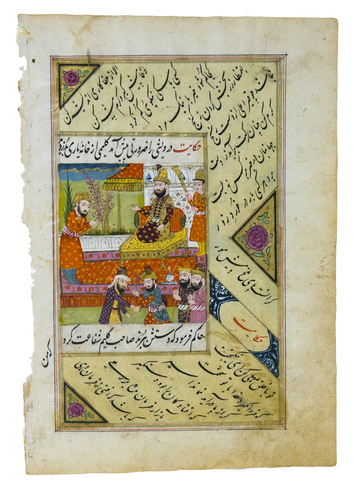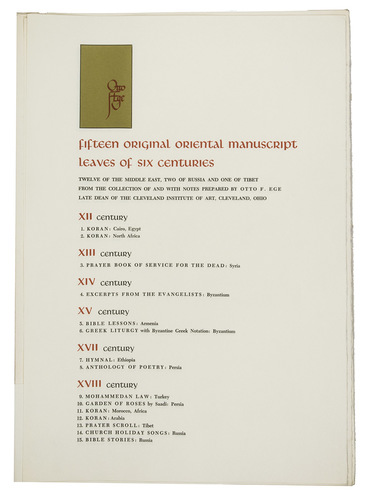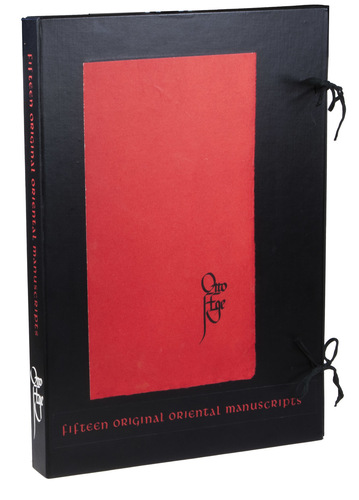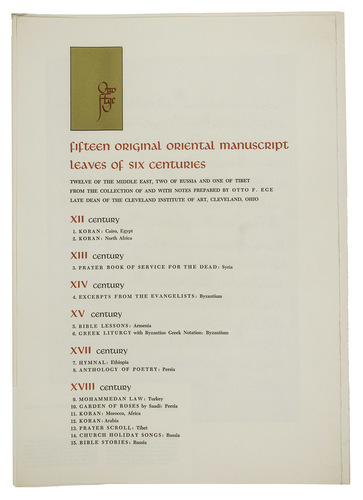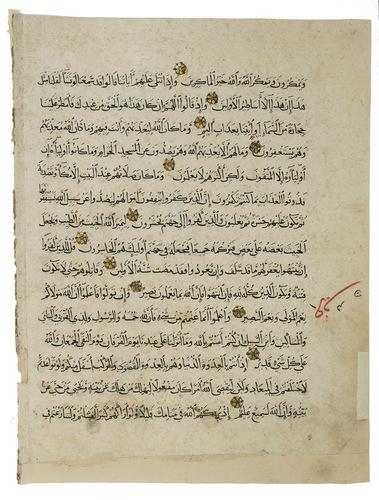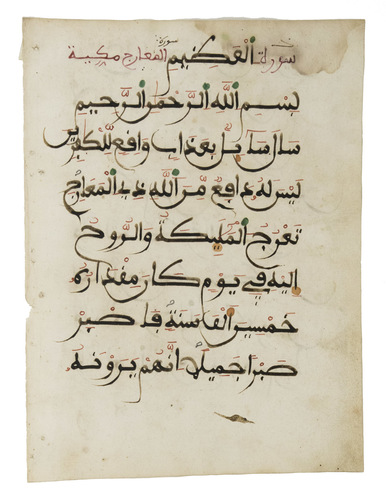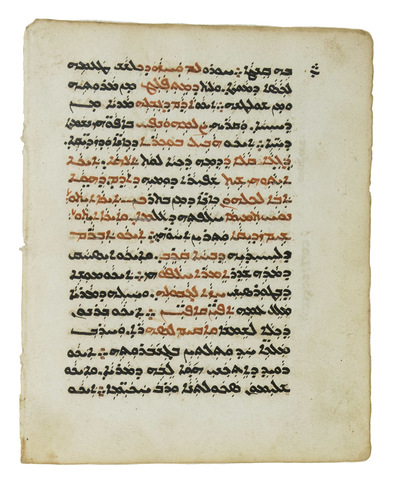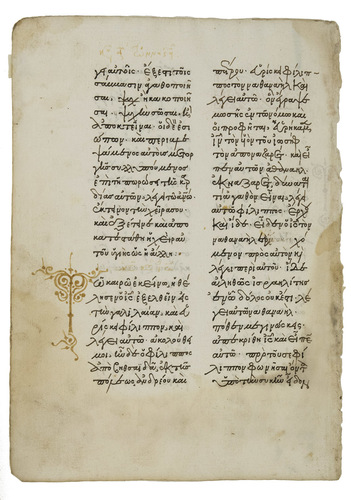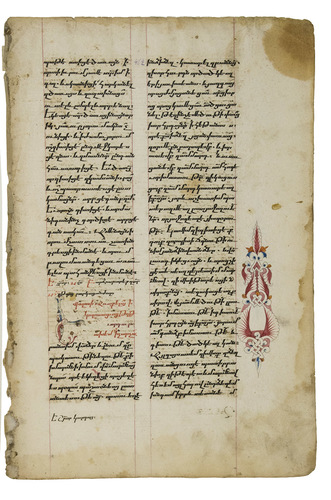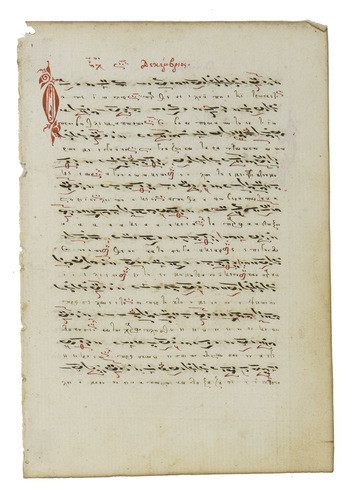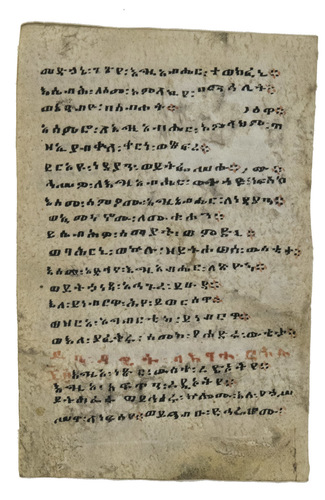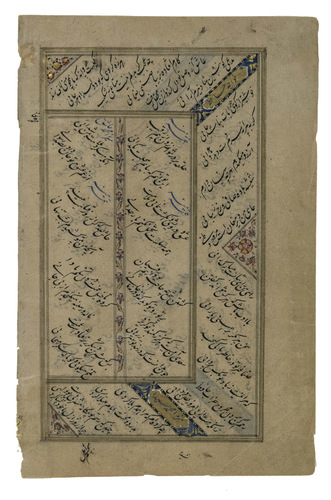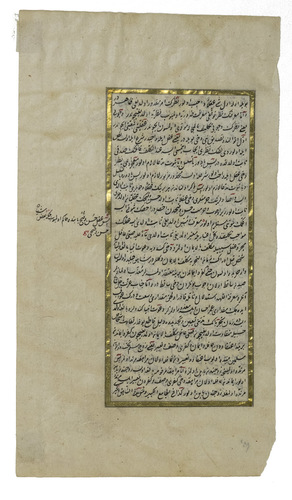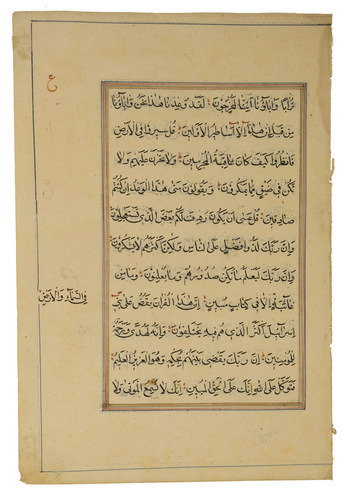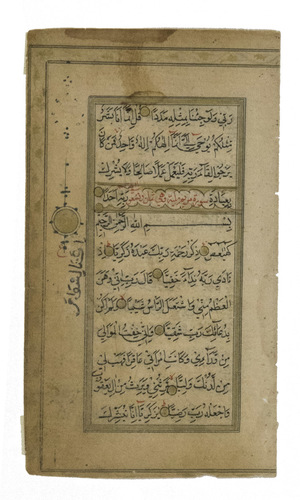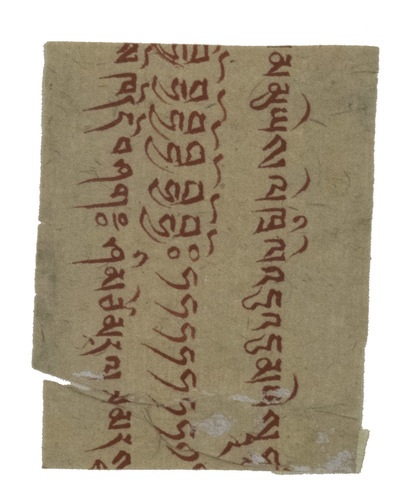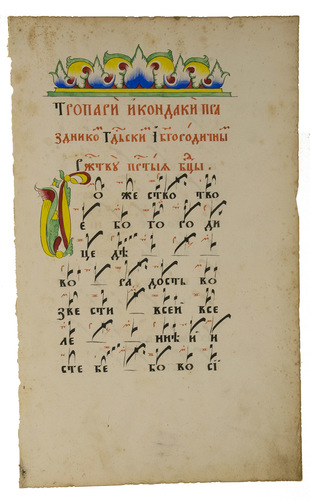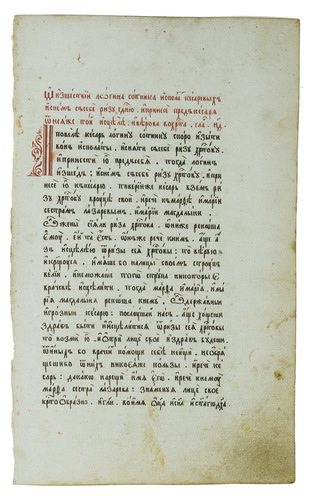EGE, Otto F (compiler & author of the annotations).
[Drop-title:] Fifteen original oriental manuscript leaves of six centuries. [Binding title:] Fifteen original oriental manuscripts.
[Cleveland, Ohio?], [Cleveland Institute of Art or Western Reserve University?], [ca. 1952]. 15 manuscript leaves (in one case a fragment of a scroll) of various formats and sizes, some glazed (see the detailed list of contents for specific dimensions), 7 written on straight-forward laid paper (European and non-European), 6 more problematic (probably all non-European), 1 on straight-forward wove paper (no. 14, supposedly made in Russia) and one on vellum (no. 7), most rubricated and/or decorated in various colours, some decorated or highlighted in gold. Each manuscript leaf is mounted (hinged on one edge to allow access to both sides of the leaf) in a passe-partout (46.5 x 33 cm) and each has a letterpress slip (10 x 18 cm) with explanatory text tipped onto the foot of the passe-partout. The publication has no title-page but includes a letterpress folio leaf that serves as a table of contents and has the drop-title given above (the present copy contains two copies of that contents leaf). The display typeface used in the letterpress leaves (and on the portfolio) is the 1938 Libra by the Dutch designer Sjoerd de Roos, inspired by uncial manuscripts. Publishers original portfolio (48.5 x 34 x 4.5 cm) covered with black cloth with on-lays in black and red on the front and the authors name in white and title in red on the spine, with three pairs of black ties (one on the inside) and a label on the inside of the right black flap giving information about the limited edition: "Edition limited to forty numbered sets of which this is No 33". [1] leaf (plus a duplicate) plus 15 original manuscript leaves mounted in white passe-partouts.
€ 18,000
Copy number 33 (from a limited edition of 40) of Eges famous portfolio containing a collection of 15 leaves from oriental manuscripts, written between the 12th and 18th centuries. The press run had to be limited because some of the manuscripts probably had no more than about 40 leaves.
Otto Frederick Ege (1888-1951) was the dean of the Cleveland Institute of Art, a lecturer on the history and the art of the book at Western (later Case Western) Reserve University in Cleveland and a famous (or infamous) biblioclast. He was one of the key figures in creating a market for medieval manuscript leaves in America during the 20th century. Between 1917 and his death in 1951, Ege acquired, broke up and subsequently dispersed hundreds of medieval and other interesting manuscripts and early printed books, wanting to give as many private collectors and public institutions as possible the opportunity to own these individual leaves. He was convinced that his purpose of inspiring as many people as possible by bringing them in contact with historical and artistic heritage, justified the means of scattering the manuscript leaves. In fairness to Ege, these were almost certainly incomplete manuscripts to begin with, though one could wish he had provided a detailed description of each manuscript before breaking them up and disbursing them, and his publications did make them available, albeit in the limited form of a single leaf, to a much greater audience than could have hoped to see, let alone own original manuscripts of this sort. Fortunately, people are now more reluctant to break up early manuscripts, but that also means that similar publications are less likely to appear in the future. Beginning in the 1940's, Ege compiled his most famous portfolios as two limited editions in press runs of 40 copies each: one portfolio with western medieval manuscript leaves and the present one with 12th to 18th century oriental manuscript leaves.
The present portfolio includes leaves from 15 manuscripts produced from the 12th to the 18th century, in Egypt, Iran, the Byzantine/Ottoman Empire, Persia/Iran, Russia, Tibet and other places. These mainly religious texts were written in several different languages, including Arabic, Syriac, Armenian, Ethiopic, Persian, Tibetan, Greek and Church Slavonic. Two of the fragments, one in Greek and one in Church Slavonic, even include music notation (neumes). Although the publication names no publisher and gives no date of publication, Ege compiled it himself and wrote the notes about each manuscript leaf, but it is said to have been published after (probably soon after) his death in 1951 (the description of Ege as "late dean of ..." is slightly ambiguous, but may indicate that he had died). His brief notes on the manuscripts lack many details and are often not reliable (particularly the dating), so we have tried to make some additions and corrections in our detailed list of the contents. One of the Cleveland institutions where he worked probably published the portfolio. It is listed in the National Union Catalog of pre-1956 imprints. As Ege intended, many of his portfolios and other fragments were sold and distributed worldwide. Beinecke Rare Book & Manuscript Library at Yale University acquired his personal collection, including 50 unbroken manuscripts, for their special collections in 2015.
A detailed list of contents is available upon request.
The portfolio, the two copies of the contents leaf and the 15 passe-partouts with the manuscript leaves are in very good condition. A detailed condition report of the 15 manuscript leaves included in the detailed list of contents, available upon request. WorldCat 15372178 (7 copies), 78768040 (2 copies), 1322443218 (1 copy).
Related Subjects:


















